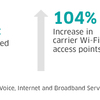By Mae Kowalke, TMCnet Contributor
Packet microwave rings are catching on as the network topology of choice for network operators when it comes to microwave backhaul networks.
Daisy chain and tree network topologies have historically been used for packet microwave due to bandwidth inefficiencies associated with the SDH/SONET protocols that historically made ring networks inefficient. All that has change with the introduction of ITU-T G.8032v2, a new standard that takes the place of SDH/SONET networking capabilities.
“This standard was designed to address IP and LTE backhaul requirements while also efficiently exploiting the inherent advantages of ring based network topologies,” noted Paolo Volpato, Product Strategy Manager, Wireless Transmission at Alcatel-Lucent in a recent TechZine posting, Packet Microwave Rings Optimize Capacity and TCO.
The new standard sends traffic in two directions around a ring, so network capacity is doubled. It also reduces capital expenditures by eliminating the need for fully protected sites.
Volpato reported that not only were there microwave capacity and availability advantages with the new ring-based approach in an analysis of a live operator deployment of the technology in the Middle East and Africa region, but the ring approach also resulted in the need for 36 percent fewer microwave radio outdoor units (ODU). This was despite the fact that the ring based approach required a few more interconnected microwave network sites/links (23 versus 18) to create ring topologies.
“The significant reduction of ODUs is due to the fact that higher capacity sites in the daisy chain model need 8 ODUs per high capacity microwave connection, whereas the ring approach only requires 4 ODUs per microwave connection,” he noted.
Less ODUs means less couplers are needed, too. The network that was analyzed did not even need any couplers, whereas a daisy chain approach would have required couplers to bring channels on to the same antenna, adding to the daisy chain deployment cost.
Almost 80 percent of the antennas in the deployment had a diameter of either one or two feet.
“This size reduction is extremely important since smaller size antennas require less space on microwave towers and reduced installation effort, further minimizing network TCO,” Volpato stressed.
Overall, the use of a ring network topology with ITU-T G.8032v2 is hard to ignore when it comes to scaling microwave capacity.












